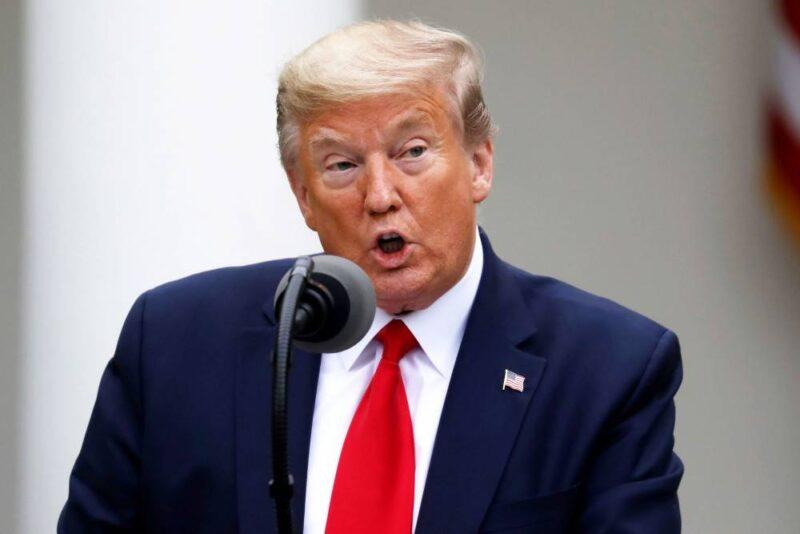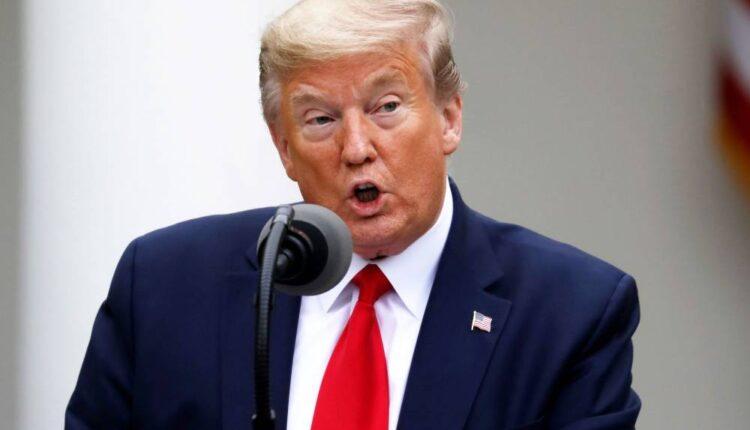
- President Donald Trump is set to unveil broad new federal guidelines laying out conditions for parts of the U.S. to start relaxing the strict measures imposed to try to slow the spread of the coronavirus.
- The new guidance will identify the necessary circumstances for areas of the country to allow employees to start returning to work – but the decision will ultimately be made by state governors, two sources told CNBC.
- The new guidance ramps up pressure on governors to loosen their restrictions, even as health experts and business leaders alike warn that widespread testing systems are needed before Americans can safely start returning to their normal lives.
President Donald Trump addresses the daily coronavirus task force briefing in the Rose Garden at the White House in Washington, April 14, 2020.Leah Millis | Reuters
President Donald Trump is set to unveil broad new federal guidelines Thursday that lay out conditions for parts of the U.S. to start relaxing some of the strict social distancing measures imposed to combat the spread of the coronavirus pandemic.
The 18-page plan for "Opening Up America Again" identifies the circumstances necessary for areas of the country to allow employees to start returning to work – but the decision to lift restrictions will ultimately be made by state governors, two sources told CNBC.
Click here to read the new federal guidelines.
States, which have imposed their own containment measures to try to slow the spread of the disease, are not legally required to follow the White House's instructions. But the new guidance nevertheless ramps up pressure on governors to loosen their restrictions, even as health experts and business leaders alike warn that widespread testing systems are needed before Americans can safely start returning to their normal lives.
"You're going to call your own shots," Trump said on a call with governors Thursday afternoon, NBC News reported, citing two people listening on the call.
Despite the president saying earlier this week that he believed some states may be able to "reopen" their economies before May, the White House guidelines do not offer any specific dates.
Rather, the plan lays out three "phases" aimed at guiding parts of the country to move incrementally toward loosening restrictions on businesses and individuals.
VIDEO1:3301:33Trump tells governors some states can open before May 1Closing Bell
Before entering the first phase, the number of cases, positive tests and reports of flu- or Covid-like symptoms in a state or region should be trending downward, the guidelines say. There should also be a "Robust testing program in place for at- risk healthcare workers, including emerging antibody testing," according to the guidelines.
Phase One of the plan says that "all vulnerable individuals" to continue to shelter in place, and encourages everyone to maintain various social distancing practices in public. But it also advises employers to "return to work in phases" if possible, while taking precautions such as closing common areas and minimizing nonessential travel.
Phase Two, which begins in areas with "no evidence of a rebound" in cases, further loosens the restrictions.
Even by the final phase, however, the guidelines still suggest that low-risk individuals "consider minimizing time spent in crowded environments" – an indication that a return to daily life untainted by the coronavirus may not be coming for a long time, if at all.
The guidelines also list "Core State Preparedness Responsibilities" that include a section on so-called contact tracing, the process of pinpointing the interactions an infected person has had in order to trace the path of the disease.
Trump, who frequently pointed to the market's strong performance through much of his first term as a central marker of his success, has expressed an eagerness to "reopen" the U.S. economy, which has ground to a halt amid the pandemic.
VIDEO3:2703:27Can the US reopen its economy soon? Here's what three pros sayThe Bottom Line
His administration declined to declare a nationwide lockdown order, opting instead to issue non-binding social distancing guidelines that were originally set to expire at the end of March. The president even said last month that he hoped to see "packed churches" on Easter Sunday – a comment quickly condemned by health experts.
The White House later revised its timeline, extending the guidance through the end of April. But at a coronavirus press briefing Tuesday, Trump said he expects some of the less-affected states will be able to lift their restrictions before May 1.
The availability of coronavirus tests remains a key issue, however. While roughly 120,000 to 140,000 Covid-19 tests are reportedly taken each day in the U.S. – about 3.3 million tests in total so far, Trump said – that rate lags behind other countries on a per-capita basis.
Without being able to screen employees and customers for the virus, Americans won't be "confident enough to return to work, eat at restaurants or shop in retail establishments," business executives told the president Wednesday, according to The Wall Street Journal.
In phone conferences earlier Thursday, Democratic House and Senate members urged Trump to wait for Covid-19 testing to become more widely available before giving advice on reopening the economy, NBC reported.
But Trump pushed back, insisting that the economy must be reopened first, according to NBC.
Trump had previously asserted "total" authority over the country's reopening. Legal experts say that claim is false because the federal government can't override state-issued public health rules – and since the White House never imposed any social distancing measures itself, there's nothing for it to reverse now.
Governors have implemented unprecedented restrictions to try to contain the spread of the virus. Nonessential businesses have been forced to shutter their doors, schools have been closed and residents have been ordered to stay in their homes except to perform necessary activities.
Those policies are working, say governors such as Andrew Cuomo of New York, the epicenter of the Covid-19 outbreak in the U.S. Cuomo has pointed to the recent decline in daily numbers of intubations and hospitalizations as evidence that widespread adherence to social distancing works.
But Cuomo on Thursday extended his state's strict containment measures through May 15 and expanded his order for people to wear masks in public.
The global efforts to blunt the impact of the crisis have upended daily life and ravaged the economy. In just four weeks, the U.S. has erased virtually all the jobs gained since the Great Recession, according to Labor Department figures released Thursday.
The coronavirus first appeared near the city of Wuhan in China's Hubei province. It has since spread around the world, infecting more than 2 million people and killing at least 138,008, data from Johns Hopkins University show.
The U.S. has reported more Covid-19 cases and deaths than any other country. More than 639,600 people have been infected and at least 30,985 have died from the virus, according to Johns Hopkins.
On Monday, numerous states banded together to form their own working groups focused on coordinating their actions to combat the crisis and developing plans for reviving their economies. Still, Trump said a day later that he will be "authorizing each individual governor of each individual state to implement a reopening and a very powerful reopening plan of their state at a time and in a manner as most appropriate."
— CNBC's Dan Mangan and Christina Wilkie contributed to this report.
Source: cnbc.com

